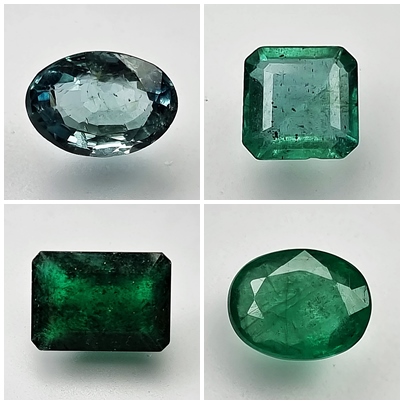
African Emerald: Gemstone Information
South Africa
In 1927 African emerald crystals were found about 20 km east-north-east of Gravelotte station in the Leysdorp district of the Letaba area of northeastern Transvaal. The deposits are associated with acid pegmatite inclusions in biotite, chlorite and actinolite schists belonging to the Swaziland system. Gem-quality crystals occur almost invariably in the biotite schists at or near contact with the pegmatite bodies. Associated with the emeralds are quartz, apatite, schorl, molybdenite, pyrite and feldspar. The crystals have unusual prismatic form and range in size up to 50 mm or more in length, but most often they are variable in color, cloudy, cracked and flawed. Silver-grey molybdenite inclusions suggest Gravelotte as a possible source. The South African emeralds rarely show red through the Chelsea color filter.
Zimbabwe
During 1956 the prospectors Contat and Oosthuizen discovered emeralds in the Belingwe district in the southern part of the country. The occurrence is located in the Mweza Greenstone Belt, in the Sandawana Valley, on the south side of the Mweza Range, the crystals occurring in tremolite schist bordering pegmatite dykes. The bright and very attractive, though usually small, crystals are highly priced today. The name Sandawana emerald is invariably used. Sandawana emeralds have an SG of near 2.75 and mean RI of 1.590 for the ordinary ray and 1.584 for the extraordinary ray, with a DR of 0.006. The inclusions are rather typical tremolite needles, occurring either as short rods or as fine, often curved, fibers, and garnets with a yellowish limonite halo. Some Zimbabwe stones have been seen to show color zoning. Zimbabwe emeralds seem to be inert under ultra-violet light and show a weak reddish under the Chelsea color filter. Emerald are found over a fairly wide area but the stones from other mines do not seem to compare with the stones from Sandawana. Other mines are the adjacent Machingwe mine, the Belingwe mine and the Mustard, Flame Lily and Cohen’s Luck claims which lie in the Filabusi Greenstone Belt to the north-west of Sandawana, and the Chikwanda, Novello, Twin Star and Mayfield claims in the Victoria Greenstone Belt to the north-east.
Tanzania
In 1970 emerald was found near the western shore of Lake Manyara at the base of the west escarpment of the Gregory Rift Valley in northern Tanzania (Schluter, Geology of East Africa, 1997, Beitrage zur regionalen Geologie zur Erde, Bd 27; ISBN 3443110274). Schluter’s account suggests that the most productive era for the Mayoka mine was from 1970 to 1973. The emerald and alexandrite occur in biotite mica schists and also in the contact zone between biotite-actinolite schists and pegmatites. The schists appear to occur as bands or lenses in the gneisses making up the rocks of the Mozambique Belt. Pegmatites in the area are usually small. The emeralds are a fine grass-green, sometimes with a yellowish or a bluish tinge, and the best-quality crystals may weigh up to about 8 ct. None of the emeralds, whatever their host, shows a deep red through the Chelsea filter. Apatite and mica flakes, with some orthoclase and quartz, are the main mineral inclusions. Properties are in the normal range for emerald.
Zambia
Emerald has been recovered from areas not far from the Zambian copper belt since about 1970. The Miku mine is about 56 km south-west of Kitwe. Other deposits in the Kafubu emerald field, SE of the Miku mine have been identified. Emeralds occur in contact zones within a talc-chlorite-amphibole-magnetite schist. The mode of occurrence echoes that of South African and Sandawan emerald; quality can be high. Properties are in the usual emerald range; solid inclusions reported include dravite, magnetite, two types of dark mica, orangered rutile, chrysoberyl, hematite and apatite.
Nigeria
Possible gem-quality blue-green beryl, which Hanni suggests be termed blue-green emeralds, are being mined from near Jos in the Rafin Gabas Hills district of Nigeria’s central Plateau state. Here, blue-green beryl occur with other colored beryl, topaz and smoky quartz in narrow stringers and thin layers forming a stock work over the roof zones of granitic hills. Moderately saturated blue-green Nigerian beryl, colored by combinations of up to 0.08% chromium, 0.06% vanadium and 1.2% iron, have a mean SG of 2.67, RI which range from 1.570 to 1.574 for the ordinary ray and 1.564 to 1.568 for the extraordinary ray, a DR of 0.006, and an absorption spectrum that displays features of both aquamarine and emerald colored by both chromium and vanadium. Inclusions include complex growth zoning, partly healed two-phase fractures and two-phase jagged cavities oriented parallel to the c-axis.
Madagascar
Emerald, with characteristics comparable to those of Zambian emerald, occurs in mica schists of the Ankadilalana mine, near Kianjavato, on the south-east coast of Madagascar. Blue-green emeralds, containing an emerald component due to chromium and an aquamarine component due to iron, have been mined for the past five years from mica schists in the Morafeno region, 30 km south of the central east coast city of Manjaray. These partly transparent emeralds have an SG of 2.68–2.71, refractive indices of 1.588–1.591 for the ordinary ray and 1.580–1.582 for the extraordinary ray, and a DR of 0.008–0.009. Inclusions include color zoning, two-, three- and multiphase partly healed fractures and negative crystals, brown mica, tremolite-actinolite rods and needles, and undetermined colorless crystals.
Mozambique
Emeralds have been found both in the mica schists of the Morrua district, or the Maria 111 mine associated with the Alto-Lingonha pegmatite region, 260 km west-south-west of Maputo. Mozambique emerald has an SG of 2.73, mean refractive indices of 1.592 for the ordinary ray and 1.585 for the extraordinary ray, and a DR of 0.007. It is included by brownish mica, and has c-axis-oriented two-phase negative crystals and growth tubes that often have basal fractures. A fine green cabochon with pyrite inclusions and a crystal similarly included have been described by MO’D.




